Lower back stretches are one of the most effective and natural ways to relieve pain, especially for women experiencing pregnancy, postpartum recovery, or a sedentary lifestyle.
Table of Contents
- Why Women Need Lower Back Stretches
- Common Causes of Lower Back Pain in Women
- Benefits of Lower Back Pain Stretches for Women
- Precautions Before Stretching
- Best Lower Back Stretches for Women with Pain Relief Focus
- Lower Back Stretches During Pregnancy
- Lower Back Stretches for Desk-Bound Women
- Gentle Exercises for Lower Back Pain Relief
- Lower Back Stretches to Avoid During Pregnancy or Postpartum
- Integrating Lower Back Stretches into a Woman’s Daily Routine
- When to Seek Professional Help
- Frequently Asked Questions (FAQs)
Why Women Need Lower Back Stretches
Lower back pain is one of the most common health complaints in the world. FIt can be even more frequent for women because of hormonal changes, shifts in pregnancy weight and the physical demands of child care. Whether you are a busy mom, in your third trimester or recovering from child birth, these lower back stretches can provide a lot of relief, and support for hours.
Common Causes of Lower Back Pain in Women
Poor Posture
Sitting too long at a desk or slouching while standing can strain your lower back muscles, particularly for postpartum women adapting to nursing positions.
Sedentary Lifestyle
A lack of movement weakens core and back muscles, making the spine more vulnerable. Many women balancing home or office work find it hard to stay active.
Pregnancy & Postpartum Changes
Pregnancy alters your center of gravity and places added stress on the lumbar spine. Postpartum, abdominal muscles are stretched and weakened, which affects spinal support.
Hormonal Changes
Relaxin hormone during pregnancy causes ligaments to loosen, causing to lack of stability and pain in the lower back.
Benefits of Lower Back Pain Stretches for Women
- Relieve tension and stiffness from carrying children or during breastfeeding
- Restore flexibility after pregnancy and delivery
- Improve circulation and support healing
- Enhance core engagement, posture, and pelvic alignment
Precautions Before Stretching
Warm-Up First
Light walking or hip mobility movements help prepare muscles.
Listen to Your Body
Never force a stretch. Discomfort is okay—pain is not. Postpartum bodies especially need gentler care.
Consult a Healthcare Professional
Especially during pregnancy or after delivery. Clearance from a doctor or physiotherapist ensures safety.
Best Lower Back Stretches for Women with Pain Relief Focus
1. Child’s Pose
What it does: Stretches the spine, hips, and thighs while promoting relaxation. This position gently stretches the lower back and helps soothe the mind, so it’s one of the most beloved positions for women who are pregnant or newly postpartum. It takes pressure off your spine and can relieve lower-back compression after hours of standing, sitting, or holding a baby.
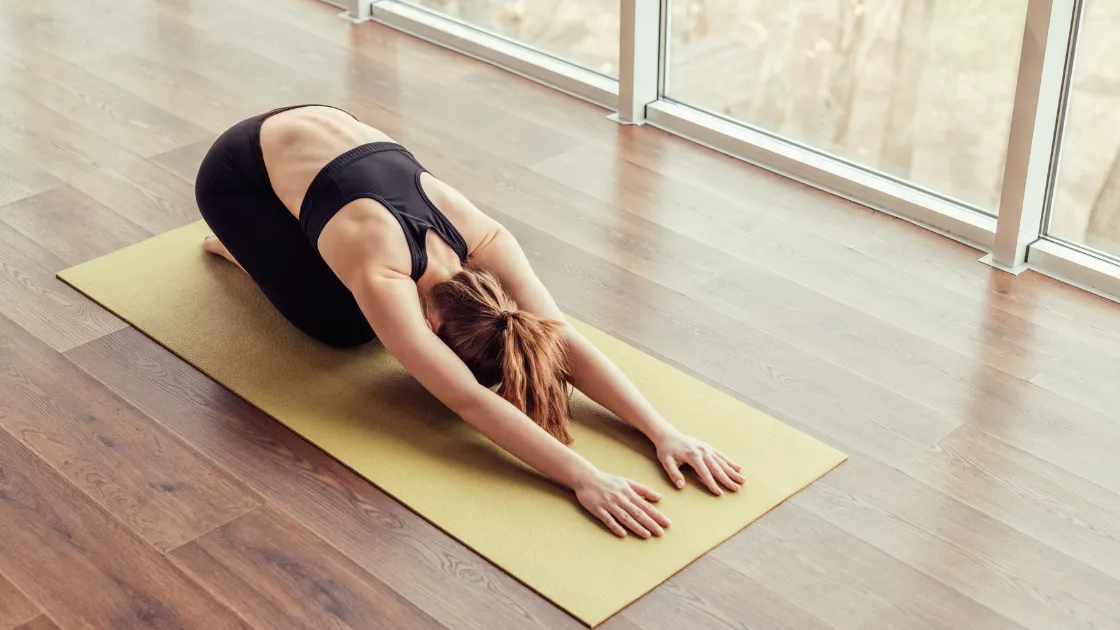
Step-by-step:
- Begin on a yoga mat on your hands and knees.
- Big toes to touch and spread the knees apart (very important, especially during pregnancy).
- Seating (keeping your heels pulled back) 10-second Seiza then walk the hands forward, and bring your butt to your heels gently.
- Reach your arms forward and bow with your forehead to the floor.
- Breathe deeply and slowly and hold the pose for 30 seconds to 1 minute.
- To exit, slowly walk your hands back and rise. ** With your chest down, sit back on heels, reaching arms forward. For Pregnancy: Slide the knees and feet apart for greater ease.
2. Cat-Cow Stretch
What it does: Mobilizes the spine and encourages better posture by relaxing the back and neck. Its also great to warm the back body up if you feel stiff whilst you are pregnant or postnatal. The pump action works the lower back and helps keep the core engaged.
Step-by-step:
- Start on all fours with the wrists under the shoulders and the knees under the hips.
- On the inhale, drop the belly down, lift the head and the tailbone up (Cow Pose).
- Round your spine toward the ceiling and tuck your chin to your chest, as you exhale (Cat Pose).
- Repeat this movement softly and gradually, moving with the breath.
- Repeat for 8–10 full rounds. ** On hands and knees, Arch and round your back (Cow/Cat) in a slow and controlled way. Breathe in as you arch, and out as you round.
3. Supine Twist
What it does: Eases spinal tension and encourages mobility in the lower back and hips. It’s a soothing stretch and it’s especially nice for creaky or post-childbirth, sitting-mom bods. It fuels the digestive fire and offers a nice, sweet stretch for the booties and spine.
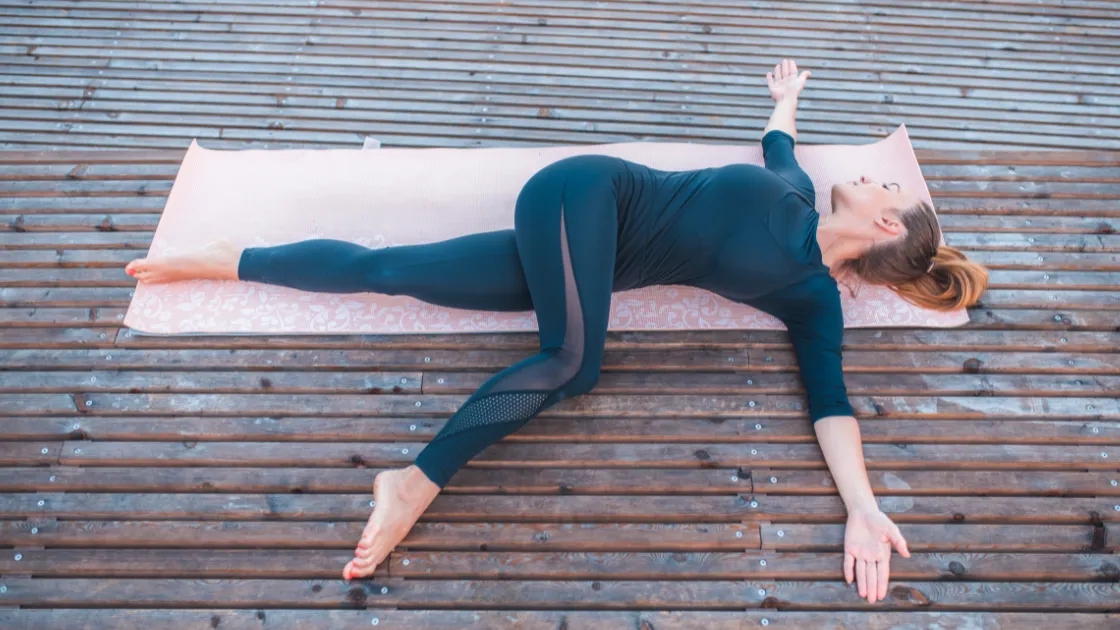
Step-by-step:
- Lay on the floor or mat on you back.
- Pull both knees up towards your chest.
- Stretch your arms out to the sides with your palms up.
- Gently lower your knees to one side, maintaining your shoulders on the floor.
- Look away from your knees.
- Remain in the pose for 30 seconds, taking deep breaths throughout.
- Draw your knees back to center and do the other side. ** Lying on your back, bend one knee and cross it over your body_seen above and below in both directions.
4. Pelvic Tilt
What it does: Builds core muscle strength and takes pressure off of the low back. It also naturally encourages postpartum women to gently work along with their core and promotes stable spine without effort.
Step-by-step:
- Lay on your back with bent knees and flat feet on the ground.
- You can put your hands on your hips or let them fall at your sides.
- Inhale to prepare.
- Contract your abdominal muscles and slowly lift hips off the floor as you exhale, pressing lower back to floor and raising hips until they are in line with torso, thighs not higher than torso.
- Maintain the tilt down for 3 to 5 seconds.
- Breath in, and move back to reposition Exercise changes If this exercise is done with a load, you could place the heel of the hand on the blade of the back or on the thigh as a loading option.
- Repeat 10–12 times. ** Begin lying on your back, knees bent. Gently rock your pelvis up and back, flattening your lower back to the floor, and release.
5. Knee-to-Chest Stretch
What it does: Stretches the hips and lower back; relieves stiffness. This is a great way to put gentle motion into your lower back and unwind from a day of being static at the desk. And it increases circulation to the pelvic region, so it’s comforting for new mamas, too.
Step-by-step:
- Lie flat on your back with your legs extended.
- Slowly bend your right knee and draw it toward your chest.
- Wrap your hands around the shin just below the knee.
- Keep your left leg straight and relaxed on the floor.
- Hold for 30 seconds, breathing deeply.
- Release and switch to the other leg.
- For added comfort, perform with both knees together if preferred.** Lie on your back and slowly draw one or both knees toward your chest. For postpartum, start with one leg at a time.
Lower Back Stretches During Pregnancy
Here are some back exercises during pregnancy that you can perform safely.
- Joint Pelvic Tilts: Help support the back and pelvis to help maintain and core strength in the back and pelvis without strain.
- Hamstring stretches (Wall-assisted): Stretch and relieve lower-back and leg tension.
- Prenatal Yoga Poses and Workouts including Butterfly Pose and Cat-Cow: Keep circulation going and reduce pressure on the belly.
Postpartum Lower Back Stretches
Bridge Pose
What it does: Strengthens the glutes, lower back, and hamstrings while gently opening up the hips. It’s a beneficial exercise for postpartum women as it rebuilds core stability and supports the spine after delivery. It also helps reduce pressure from prolonged sitting and enhances blood circulation in the pelvic area.
Step-by-step:
- Lie on your back with knees bent and feet hip-width apart.
- Keep your arms relaxed by your sides with palms facing down.
- Inhale and press through your heels.
- Lift your hips toward the ceiling, squeezing your glutes.
- Hold the position for 5–10 seconds while breathing steadily.
- Slowly lower your hips back down to the mat.
- Do 8–12 reps, or as many as you feel comfortable. ** Begin lying back on the mat or a bench with the knees bent. Press into your feet to elevate your hips up off the floor, contracting the glutes. Start with short holds.
Reclined Pigeon Pose
What it does: Opens up tight hips and glutes, reducing tension in the lower back and improving overall mobility. This pose is especially useful for postpartum women as hip tightness often contributes to back discomfort.
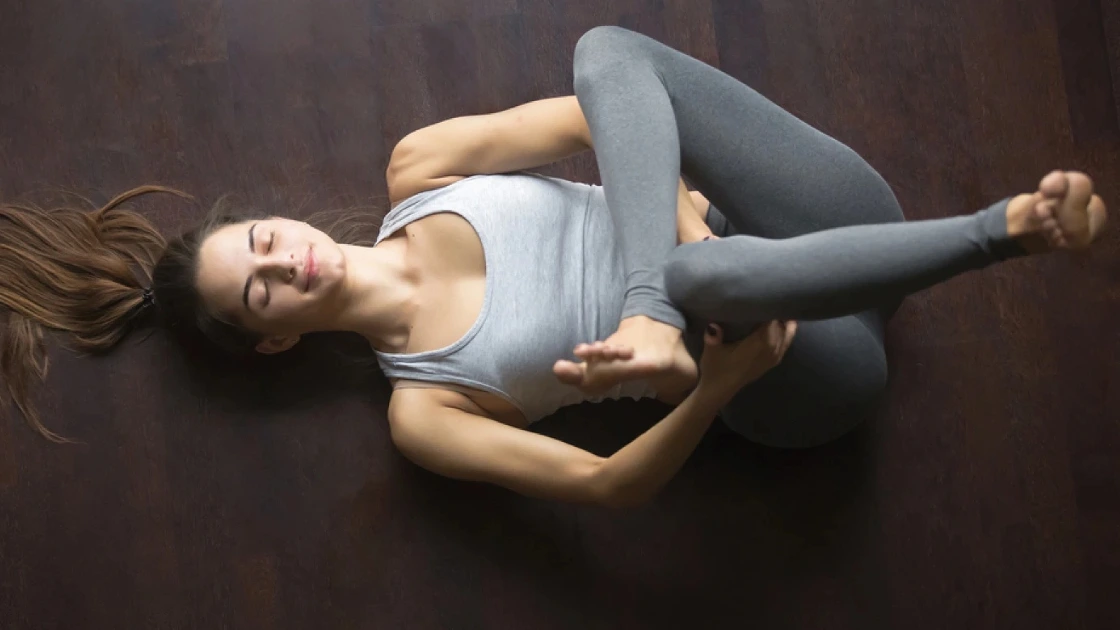
Step-by-step:
- Lie flat on your back with knees bent and feet flat on the floor.
- Cross your right ankle over your left thigh, just above the knee.
- Thread your right hand through the space between your legs and clasp both hands behind the left thigh.
- Gently draw the left leg toward your chest until you feel a stretch in the right hip.
- Keep your head and shoulders relaxed on the mat.
- Hold for 30 seconds to 1 minute, then switch sides.** Lie on your back, cross one ankle over the opposite thigh, and gently draw the legs in.
Deep Breathing with Core Engagement
What it does: Promotes relaxation and reactivates core and pelvic floor muscles perfect for women who are recovering from childbirth. It also assists with emotional equilibrium, and the release of stored tension in the belly and lower back.
Step-by-step:
- Be seated or lie down in a relaxing position.
- Put one hand on your chest and the other on your belly.
- Take a deep breath through your nostrils, allowing your belly to fill.
- Exhale slowly through your mouth, gently drawing your navel inward and engaging your pelvic floor.
- Hold the contraction for a moment, then release.
- Do this for 5–10 breaths, emphasising a slow and controlled movement. ** Breathe in deeply, then as you breathe out draw in your core and lift up through your pelvic floor.
Lower Back Stretches for Desk-Bound Women
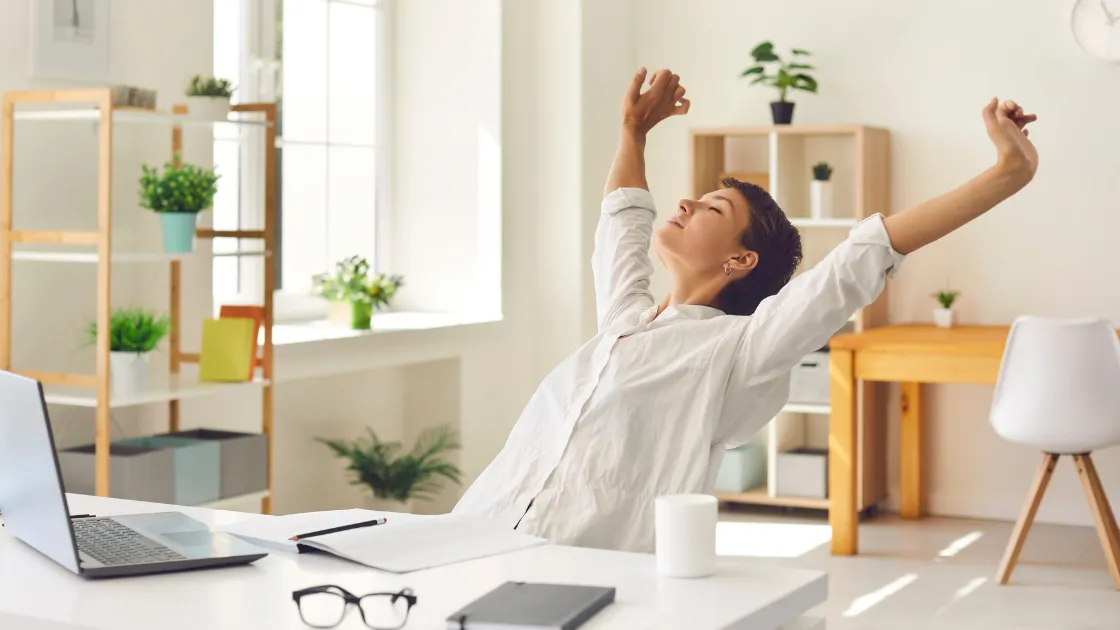
After breaks, Try these to avoid chronic pain:
- Seated Spinal Twist: A gentle twist for the spine to counteract the effects of extended sitting.
- Standing Backbend Stretch: Works to counteract excessive forward hunching, releases back tension.
- Standing Forward Bend with Bent Knees: Stretches out the lower back and hamstrings without compressing.
How to Stretch Lower Back Safely for Moms and Moms-to-Be
- Move slowly into each position
- Take a deep breath and hold each stretch for 20–30 seconds
- Modify positions for comfort and avoid anything that strains your belly
Gentle Exercises for Lower Back Pain Relief
Incorporating strengthening moves helps women maintain posture and avoid chronic discomfort.
Bird-Dog
What it does: Your core, glutes, and lower back are also strengthened as your overall balance and coordination improves. It’s safe and effective post-delivery for women who have just given birth to regain stability without adding pressure to the abdomen.
Step-by-step:
- Start in tabletop with your hands under your shoulders and your knees under your hips.
- Engage your core and keep your back flat.
- Reach your right arm in front of you and your left leg behind you, both parallel to the floor.
- Hold for 5 seconds, keeping hips level.
- Return to the starting position.
- Repeat on the opposite side.
- Perform 8–10 reps on each side.** On hands and knees, extend one arm and the opposite leg. Hold, then switch.
Glute Bridge
What it does: Activates the glutes, hamstrings, and lower back. It’s highly recommended for postpartum women to regain pelvic and spinal stability and reduce back discomfort caused by weakened core muscles.
Step-by-step:
- Lie on your back with knees bent and feet flat, hip-width apart.
- Let your arms hang at your sides, palms down.
- Press your feet into the ground and lift your hips up.
- Squeeze your glutes at the top and hold for 5 seconds.
- Regress your hips back to the floor.
- Repeat for 10–15 reps, depending on strength and comfort.** Lie on your back, feet flat. Lift hips and hold. Lower slowly.
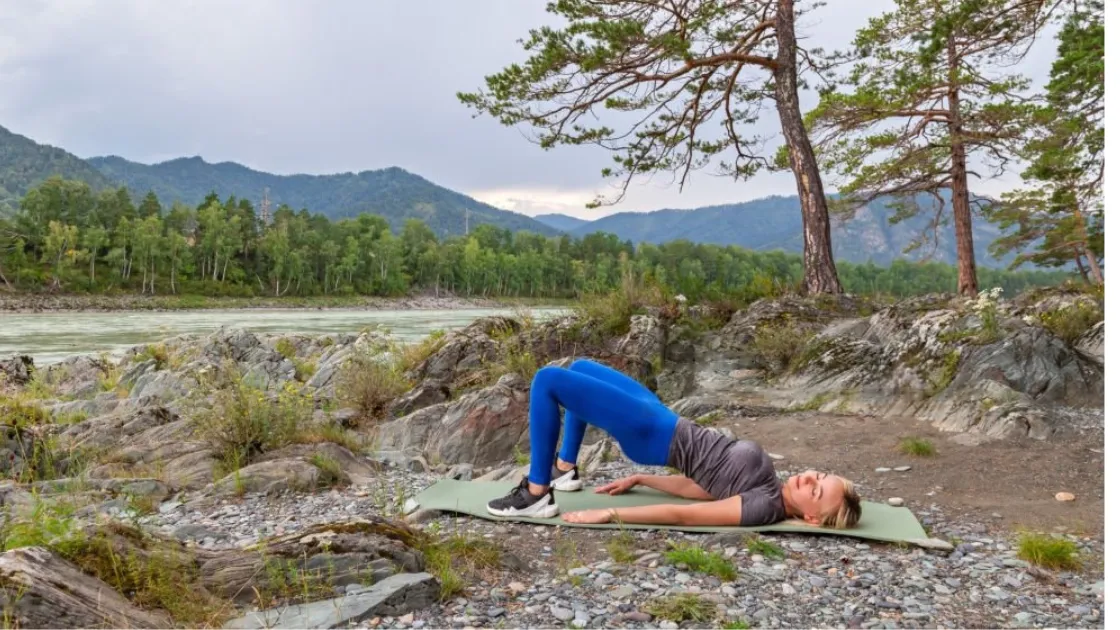
Wall Sits
What it does: Builds strength in the thighs, glutes, and core—all essential for lower back support. This static hold also improves posture and muscular endurance in women, particularly helpful after childbirth.
Step-by-step:
- Stand with your back flat against a wall.
- Slide down until your thighs come to the parallel of the floor, knees directly above your ankles.
- Keep your feet hip-width apart and press your lower back into the wall.
- Hold the position for 15–30 seconds to start.
- Gradually increase the duration as you get stronger.
- Rise gradually to come back to the starting position. ** Slid down a wall so your thighs are parallel to the floor. Hold the position.
Lower Back Stretches to Avoid During Pregnancy or Postpartum
- Toe touches (can strain the lower spine)
- Deep backbends (like Cobra pose if you’re not warmed up)
- Any move that causes shooting or sharp pain or puts pressure on the belly
Integrating Lower Back Stretches into a Woman’s Daily Routine
Morning
Loosen stiffness with cat-cow and pelvic tilts.
Mid-Day
Stand and stretch if you’ve been sitting for long.
Evening
Wind down with child’s pose and supine twist to promote restful sleep.
Lifestyle Tips for Women to Reduce Lower Back Pain
- Use ergonomic chairs and lumbar support
- Stay hydrated
- Practice prenatal or postpartum yoga
- Avoid prolonged sitting without breaks
When to Seek Professional Help
If lower back stretches or exercises don’t relieve your pain, or if symptoms worsen, see a women’s health physiotherapist or OB-GYN. Persistent pain could indicate something more serious.
Frequently Asked Questions (FAQs)
Q: How often should I do lower back stretches?
A: Daily is ideal, but even 3–4 times a week can offer benefits.
Q: Are lower back stretches safe during pregnancy?
A: Yes, many gentle lower back stretches, such as pelvic tilts and so on, and prenatal yoga poses are safe. Always consult your doctor first.
Q: What’s the difference between lower back stretches and exercises for lower back pain?
A: Lower back stretches help release tension, while exercises build strength to prevent pain.
Q: Can stretching make my back pain worse?
A: If done incorrectly or without warming up, yes. Always stretch slowly and carefully.
Q: Do I need equipment for these lower back stretches?
A: No, most can be done on a yoga mat or carpeted floor.
For more expert-backed suggestions be with Pregnancy Must.
Explore More-
